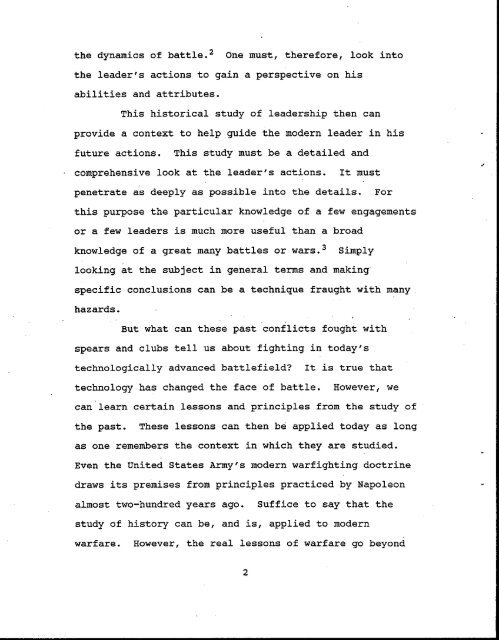- Page 3 and 4: ABSTRACT MARSHAL LOUIS N. DAVOUT AN
- Page 5 and 6: TABLE OF CONTENTS ?&%slsAPPROVALPAG
- Page 7: CHAPTER 1 BUT WHAT ARE WE TO UNDERS
- Page 11 and 12: This fact becomes even more obvious
- Page 13 and 14: the grand tactic. Operational warfa
- Page 15 and 16: Burgundian countryside. He was born
- Page 17 and 18: In1803 Davout was given command of
- Page 19 and 20: then launch a major offensive into
- Page 21 and 22: This attack'then ensured victory fo
- Page 23 and 24: would actually go to war. However,
- Page 25 and 26: Bluecher made four unsuccessful att
- Page 27 and 28: fight entirely on his own. The batt
- Page 29 and 30: title until two years after the bat
- Page 31 and 32: Without hesitation Davout pushed fo
- Page 33 and 34: most of his marshals, generals, the
- Page 35 and 36: CHAPTER 3 THE AUSTRIANS ARE OUR WOR
- Page 37 and 38: Finally, with Davout's information
- Page 39 and 40: Austrian influence in Germany and I
- Page 41 and 42: organization, always slow to act. M
- Page 43 and 44: course of action. They now had a be
- Page 45 and 46: elieved Prince Eugene and Marshal A
- Page 47 and 48: 22 March Davout had sent a message
- Page 49 and 50: were designated VII Corps and consi
- Page 51 and 52: and intelligence at the strategic l
- Page 53 and 54: across the Danube. The Austrians al
- Page 55 and 56: transmitted from Napoleon to Berthi
- Page 57 and 58: Normally, the message dispatched by
- Page 59 and 60:
me that the best maneuver would be
- Page 61 and 62:
Berthier chose to overlook this cor
- Page 63 and 64:
Landshut were only one corps and no
- Page 65 and 66:
destroy him. On the eighteenth Char
- Page 67 and 68:
critical for the French. Napoleon r
- Page 69 and 70:
Throughout these ten days before th
- Page 71 and 72:
CHAPTER 5 YOU ONLY HAVE A CURTAIN O
- Page 73 and 74:
Gudin to support the movement of hi
- Page 75 and 76:
well. They bought Davout the necess
- Page 77 and 78:
The remainder of the Austrians then
- Page 79 and 80:
His tactical leadership was at its
- Page 81 and 82:
Napoleon's vision of the battlefiel
- Page 83 and 84:
against the French. His troops succ
- Page 85 and 86:
to surrender at 5:00 P.M. Now Charl
- Page 87 and 88:
pursuit on two parallel roads leadi
- Page 89 and 90:
important part in Davout's decision
- Page 91 and 92:
orders and directions. While Davout
- Page 93 and 94:
Corps. He received no reply from th
- Page 95 and 96:
convinced he was being attacked by
- Page 97 and 98:
CHAPTER 6 THE DUKE OF AUERSTAEDT IS
- Page 99 and 100:
eginning to feel the fatigue of con
- Page 101 and 102:
Just as the Austrians began to move
- Page 103 and 104:
effect, Davoutfs forces became the
- Page 105 and 106:
The French carabiniers fired a volZ
- Page 107 and 108:
Charles would lose his desire to st
- Page 109 and 110:
The ~re'nch prevailed over the Aust
- Page 111 and 112:
CHAPTER 7 IN BATTLE MEN ARE NOTHING
- Page 113 and 114:
counter orders did nothing but conf
- Page 115 and 116:
doctrine, and most importantly the
- Page 117 and 118:
The art of war on land is an art of
- Page 119 and 120:
Maintaining this vision or coup d'o
- Page 121 and 122:
internal fears rather than obstinac
- Page 123 and 124:
who never made a mistake. The key i
- Page 125 and 126:
too seemed only to be small diversi
- Page 127 and 128:
helped to provide definition to the
- Page 129 and 130:
Figure 1.Theater of Operations.
- Page 131 and 132:
INITIALACTIONSABOUT 1500Counteratta
- Page 133 and 134:
Figure 5.Davout's Running Fight on
- Page 135 and 136:
N1- 'LABER RIVER' SCHlERLlNGLANNESI
- Page 137 and 138:
Reserve Division: Demont' (3,215) 2
- Page 139 and 140:
APPENDIX C ORDER OF BATTLE CHANGES
- Page 141 and 142:
ll~avidG. Chandler, The Cam~aians o
- Page 143 and 144:
3~hisis noted in Napoleon's corresp
- Page 145 and 146:
20~his is from correspondence numbe
- Page 147 and 148:
WORKS CITED Primarv Sources Bonapar
- Page 149 and 150:
Arnold, James R. Crisis on The Danu
- Page 151 and 152:
ackground material and specifics on
- Page 153 and 154:
secondary source but all informatio
- Page 155 and 156:
INITIAL DISTRIBUTION LIST 1. , Comb
- Page 157:
STATEMENT A: Approved for public re




